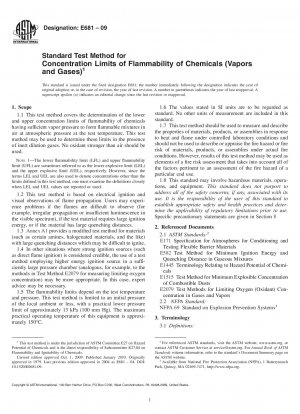ASTM E681-09
Standard Test Method for Concentration Limits of Flammability of Chemicals (Vapors and Gases)
- Standard No.
- ASTM E681-09
- Release Date
- 2009
- Published By
- American Society for Testing and Materials (ASTM)
- Status
- Replace By
- ASTM E681-09(2015)
- Latest
- ASTM E681-09(2023)
- Scope
The LFL and UFL of gases and vapors define the range of flammable concentrations in air.
5.2 This method measures the LFL and UFL for upward (and partially outward) flame propagation. The limits for downward flame propagation are narrower.
Limits of flammability may be used to determine guidelines for the safe handling of volatile chemicals. They are used particularly in assessing ventilation requirements for the handling of gases and vapors. NFPA 69 provides guidance for the practical use of flammability limit data, including the appropriate safety margins to use.
5.4 As discussed in Brandes and Ural , there is a fundamental difference between the ASTM and European methods for flammability determination. The ASTM methods aim to produce the best representation of flammability parameters, and rely upon the safety margins imposed by the application standards, such as NFPA 69. On the other hand, European test methods aim to result in a conservative representation of flammability parameters. For example, in this standard, LFL is the calculated average of the lowest go and highest no-go concentrations while the European test methods report the LFL as the minimum of the 5 highest no-go concentrations.
Note 28212;For hydrocarbons, the break point between nonflammability and flammability occurs over a narrow concentration range at the lower flammability limit, but the break point is less distinct at the upper limit. For materials found to be non-reproducible per 13.1.1 that are likely to have large quenching distances and may be difficult to ignite, such as ammonia and certain halogenated hydrocarbon, the lower and upper limits of these materials may both be less distinct. That is, a wider range exists between flammable and nonflammable concentrations (see Annex A1).
1.1 This test method covers the determination of the lower and upper concentration limits of flammability of chemicals having sufficient vapor pressure to form flammable mixtures in air at atmospheric pressure at the test temperature. This test method may be used to determine these limits in the presence of inert dilution gases. No oxidant stronger than air should be used.
Note 18212;The lower flammability limit (LFL) and upper flammability limit (UFL) are sometimes referred to as the lower explosive limit (LEL) and the upper explosive limit (UEL), respectively. However, since the terms LEL and UEL are also used to denote concentrations other than the limits defined in this test method, one must examine the definitions closely when LEL and UEL values are reported or used.
1.2 This test method is based on electrical ignition and visual observations of flame propagation. Users may experience problems if the flames are difficult to observe (for example, irregular propagation or insufficient luminescence in the visible spectrum), if the test material requires large ignition energy, or if the material has large quenching distances.
1.3 Annex A1 provides a modified test method for materials (such as certain amines, halogenated materials, and the like) with large quenching distances which may be difficult to ignite.
1.4 In other situations where strong ignition sources (such as direct flame ignition) is considered credible, the use of a test method employing higher energy ignition source in a sufficiently large pressure chamber (analogous, for example, to the methods in Test Method E2079 for measuring limiting oxygen concentration) may be more appropriate. In this case, expert advice may be necessary.
1.5 The flammability limits depend on the test temperature and pressure. This test method is limited to an initial pressure of the local amb......
ASTM E681-09 Referenced Document
- ASTM E1445 Standard Terminology Relating to Hazardous Potential of Chemicals
- ASTM E1515 Standard Test Method for Minimum Explosible Concentration of Combustible Dusts
- ASTM E171 Standard Specification for Standard Atmospheres for Conditioning and Testing Flexible Barrier Materials
- ASTM E2079 Standard Test Methods for Limiting Oxygen (Oxidant) Concentration in Gases and Vapors
- ASTM E582 Standard Test Method for Minimum Ignition Energy and Quenching Distance in Gaseous Mixtures
ASTM E681-09 history
- 2023 ASTM E681-09(2023) Standard Test Method for Concentration Limits of Flammability of Chemicals (Vapors and Gases)
- 2009 ASTM E681-09(2015) Standard Test Method for Concentration Limits of Flammability of Chemicals (Vapors and Gases)
- 2009 ASTM E681-09 Standard Test Method for Concentration Limits of Flammability of Chemicals (Vapors and Gases)
- 2004 ASTM E681-04 Standard Test Method for Concentration Limits of Flammability of Chemicals (Vapors and Gases)
- 2001 ASTM E681-01 Standard Test Method for Concentration Limits of Flammability of Chemicals (Vapors and Gases)
- 2001 ASTM E681-98 Standard Test Method for Concentration Limits of Flammability of Chemicals (Vapors and Gases)
- 1985 ASTM E681-85 Standard Test Method for Concentration Limits of Flammability of Chemicals (Vapors and Gases)
